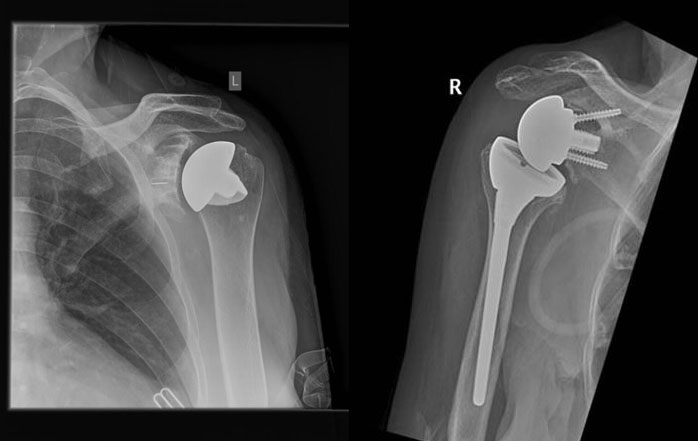
Reverse Total Shoulder Replacement
A reverse total shoulder replacement is an orthopaedic procedure used to maintain the shoulder joint for people who have arthritis of the shoulder AND an irreparable, retracted rotator cuff tear.
The rotator cuff is what enables us to lift our arms up; and damage to the rotator cuff is a common cause of shoulder weakeness. These symptoms become more common as people age. Up to 50 per cent of people over the age of 75 years have a tear in one or other rotator cuff tendons.
Read more about reverse total shoulder replacements
- How patients commonly present
- How a diagnosis is made
- How these problems are treated (both operative and non-operative options)
- Questions Dr Duckworth is frequently asked

X-Rays of a standard shoulder replacement (left) and a reverse shoulder replacement (right)
Who benefits from a reverse shoulder replacement?
This condition usually occurs in older people and results in a painful shoulder with loss of motion and strength. Often, individuals can’t raise their arm to shoulder level, making it difficult to perform routine activities of daily living.
A reverse total shoulder replacement creates an artificial ball in the shoulder and a deeper, more stable socket in the top of the humerus. With this new configuration, existing muscles such as the deltoid can adequately support the joint in the absence of a functioning rotator cuff.
This new design leads to a more stable shoulder joint that can function without a rotator cuff. The artificial joint provides more stability by creating a deeper socket that prevents the ball from sliding up and down as the shoulder is raised.
The deltoid muscle that covers the shoulder is used lift the arm, providing better function of the shoulder. The result is a better functioning shoulder with less pain.
The procedure takes about two hours, which is similar to conventional shoulder replacement surgery.
The majority of patients experience a significant improvement of function and range of motion and a significant loss of pain.
The reverse total shoulder replacement was originally designed in France in the late 1980’s and has slowly become available in Australia since the early 2000’s. According to the National Joint Replacement Registry, more than 1500 shoulder replacements were performed in New South Wales in 2014.
How is it different to a standard shoulder replacement?
Standard shoulder replacements can’t be used when there are no rotator cuff tendons. If a conventional replacement was used, the ball would slowly move up (superiorly) due to no rotator cuff tissue to hold it centred in the socket. As a consequence, the glenoid (socket) replacement would loosen and the conventional replacement would fail.
The answer to this dilemma was to reverse the socket and the ball, placing the ball portion of the shoulder where the socket used to be and the socket where the ball or humeral head used to be (ie the reverse total shoulder replacement).
For specific advice regarding reverse total shoulder replacements, please book an appointment with Dr David Duckworth on (02) 9806 3333